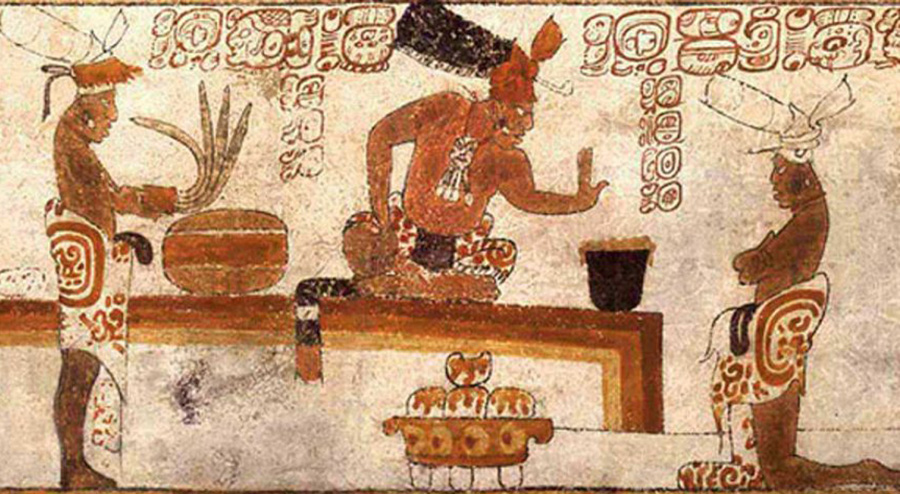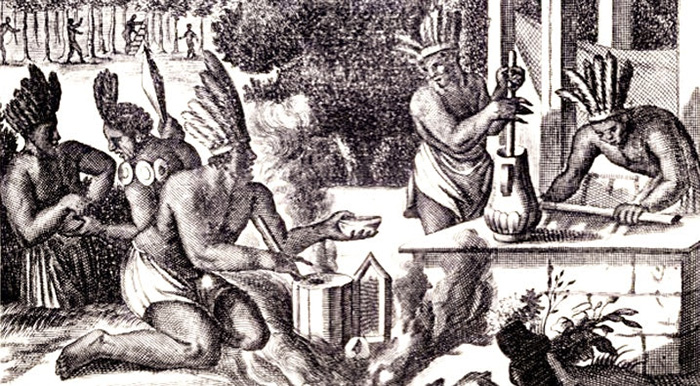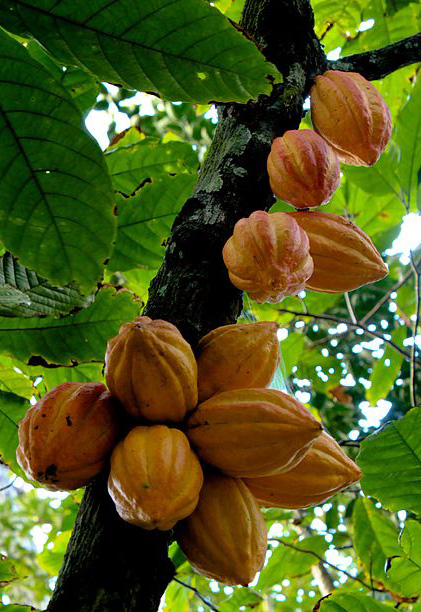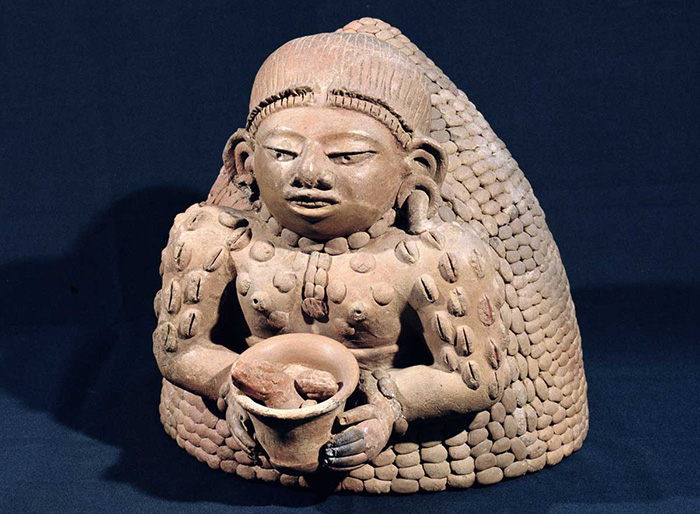Chocolate—Food of the Gods in Mesoamerica
Did you know… Money grows on trees?

Mayans used chocolate as currency. OpenCulture.com
[January 30, 2023 | Montrose Mirror | By Kathryn R. Burke]
Did you know? The phrase, “Money doesn’t grow on trees,” was coined by the Spaniards in the 1500s when they saw cocoa beans used as currency by the Aztec, who considered it more valuable than gold. To the Spanish (who were after their gold, “A tolerably good slave was worth around 100 beans, a rabbit cost 10 beans, and a prostitute could be procured for as few as 8 beans.”(1, 15)
Chocolate as a food source with magical stimulant properties dates back more than 5,000 years in Mesoamerica, (a term used to describe Mexico and Central America before the 16th century Spanish conquest). “The first known use of cacao is believed to have been discovered in southern Ecuador near Palanda at Santa Ana La Florida in the region of Zamora Chinchipe, where 5,500-year-old ceramic pots and a piece of a mortar were found to contain traces of theobromine, a marker for cacao. Shamans among the Shuar Indians are said to have used this equipment to prepare hallucinogenic potions.”(15)
The earliest image of preparing chocolate appears on a Mayan Vase…which also depicts human sacrifice; chocolate was a part of the ritual. The drink, a combination of chocolate and the blood of previous victims, was given to calm or “bewitch” the victim before they lopped of his head.(3)
The most notorious chocolate lover in Mesoamerica was the Aztec emperor Montezuma II. He allegedly drank gallons of it from a gold goblet every day…for energy and as an aphrodisiac. Unfortunately, Montezuma welcomed Hernán Cortés and the conquistadors with chocolate…thinking Cortés was reincarnated deity instead of a conquering invader.(4) Big mistake. The Spaniards came for his gold, got it—over 8 tons by some accounts—and took a boatload (literally) of cacao with them when they sailed back to their homeland, leaving Montezuma dead in their wake. Adding insult to injury, Cortés, who didn’t care for the royal drink, described it as “a bitter drink for pigs.”(4)

Aztec’s making chocolate. 1685 Granger. Mariebelle.com
Despite that old saying that money does not grow on trees, it actually does when it comes from chocolate’s origin, the tropical cacao tree of Central and South America. It was probably was first discovered as a food source in the Orinoco River basin, which flows from Columbia through Venezuela to the Atlantic Ocean(11) where the Maya lived. The Aztecs prized cacao, but they couldn’t grow it where they lived in the dry highlands (of Mexico). So they traded for it, using it as currency. By one account, a hen or a hare was worth 100 beans.(3)
Giant bean-like pods, the “fruit” of the tree, up to a foot long and weighing as much as a pound, grow directly from its trunk (or largest branches). The pods are whacked off, split open with a large knife or machete, and the seeds (called beans), as many as 60 at a time, scooped out of the pod’s fleshy interior. Interesting fact: cacao fruit is pollinated by tiny flies, not bees or butterflies.(9)

Cacao tree with seed pods, which could grow up to 1 foot long and way over a pound. Wikipedia. Public Domain.
As the seeds dry, they turn a rich cocoa brown. The dry seeds are pounded into a powder with stone and mortar, and the result made into a bitter, frothy drink, often mixed with chilis and vanilla…but never sugar. Each seed is about 50% fat (the source of cocoa butter).
The fermented pulp can also be made into an alcoholic beverage. A recent discovery of cacao residue on pottery excavated in Honduras, that could date back as far as 1400 B.C.E., suggests that the sweet pulp of the cacao fruit, which surrounds the beans, was fermented into an alcoholic beverage, much as it is today.(4) (Have you ever tried a chocolate martini? They’re lethal!)

Woman holding cacao (and decorated with cacao beans), Maya, AD 250-450. ©Bridgeman Images, Jean Pierre Courau.
An active ingredient of cacao is Theobromine, a stimulant similar to caffeine also found in tea, although this was not discovered until the 1800s by a Russian chemist.(7) This explains the use of cacao as an energy booster. Chocolate has often been given to soldiers for that reason. In WWII, Hershey bars were given to troops storming the beaches of Normandy(8) In the American Revolutionary war, it was also used as currency. Soldiers were given a chocolate paycheck in place of actual money.(1) Back to that thought that money does grow on trees. Interesting fact: Theobromine is also used in some cosmetics.
Questions: Who first thought to harvest a cacao pod. And why? They’re ugly, the seeds are hard to process, and the resulting drink bitter. How did such a beverage become a sign of wealth and power and revered as a gift of the gods?
“Who would have thought, looking at this, that you can eat it?” said Richard Hetzler, executive chef of the café at the Smithsonian’s National Museum of the American Indian, as he displayed a fresh cacao pod during a recent chocolate-making demonstration. “You would have to be pretty hungry, and pretty creative!”(4)
One theory suggests people eating the fruit and spitting the seeds into the fire noted the rich smell as they roasted. and thought “Maybe there is something more to this.”(13)
Whatever the reasons, ancient Mesoamericans were creative when they discovered cacao and what you could do with it. Chocolate has been around for over 5.300 years. It may have started with the Olmec, an ancient civilization (of southern Mexico) that left little trace and may have used it as a ceremonial drink. Olmec pots and vessels from around 1500 B.C. were discovered with traces of theobromine.(2,3)

Mayan woman preparing chocolate drink. Public domain.
The Maya civilization, which followed, was one of the most dominant Indigenous societies of Mesoamerica, and they did leave written history. They used cacao for ceremonies and trade and believed it to have mystical and medicinal qualities which could also increase libido. The Maya were deeply religious, and worshiped various gods related to nature, including the gods of the sun, the moon, rain, and corn. They considered chocolate to be the food of the gods, held the cacao tree to be sacred, and buried dignitaries with bowls of chocolate. Cacao played a big part in their rituals and religious. Interesting fact: The Latin name for the cacao tree, Theobroma cacao, literally means “food of the gods.”(4)
The wealthier Mayan households enjoyed chocolate as a thick, frothy beverage often seasoned with chili peppers, honey, vanilla and other spices. (Have you ever purchased a 90% Cacao candy bar flavored with chili?) The less affluent usually had it cold, in a porridge-like dish.(3)
The Aztec couldn’t grow cacao, so they traded for it. They considered chocolate more valuable than gold and a gift from the gods. (All of which contributed to their society’s decline.) According to a 15th century Aztec document: One bean could be traded for a tamale, while 100 beans would by a good turkey hen.(3)
Aztec chocolate, which they called xocolatl, was mostly an upper-class extravagance, although the lower classes enjoyed it occasionally at weddings or other celebrations.(2) Like the Mayans, “the Aztec considered the cacao bean magical, or even divine” and used it in sacred rituals, including birth, marriage, death, and human sacrifice.
It was the Spanish who first brought cacao to Europe. Read more here, how chocolate went from a bitter drink to a sweet confection for the elite, and eventually, for the masses.
Sources
- 1) Chocolate Wars. The 150-Year Rivalry Between the World’s Greatest Chocolate Makers. Deborah Cadbury. Public Affairs. 2010.
- 2) History of Chocolate. com https://www.history.com/topics/ancient-americas/history-of-chocolate
- 3) “Chocolate’s Sweet History: From Elite Treat to Food for the Masses.” com https://www.history.com/news/the-sweet-history-of-chocolate
- 4) “A Brief History of Chocolate.” Smithsonian Magazine. Amanda Fiegl. 2008. https://www.smithsonianmag.com/arts-culture/a-brief-history-of-chocolate-21860917/
- 5) “The Death of Emperor Montezuma.” By Christopher Minster. Updated May 2021.
https://www.thoughtco.com/the-death-of-montezuma-2136529 - 6) A True History of Chocolate. Sophie D. Coe. Michael D. Coe. Thames and Hudson. 3rd June 2013.
- 7) “Theobromine.” Wikipedia. https://en.wikipedia.org/wiki/Theobromine
- 8) “How Hershey’s Chocolate Helped Power Allied Troops During WWII.” history. com
https://www.history.com/news/hersheys-chocolate-allied-d-day-rations-wwii - 9) “Theobroma cacao” (cacao tree) Wikipedi https://en.wikipedia.org/wiki/Theobroma_cacao
- 10) “How the Ancient Mayans Used Chocolate as Money” Open Culture (Oct. 2018_
https://www.openculture.com/2018/10/ancient-mayans-used-chocolate-money.html - 11) “Early Origins of Chocolate Under Aztec Rule.” com
https://mariebelle.com/blogs/blog/early-origins-of-chocolate-under-aztec-rule - 12) “The Theology of Chocolate.” History Today.
https://www.historytoday.com/archive/history-matters/theology-chocolate
- 13) “What We Know About the Earliest History of Chocolate.” Josie Garthwaite. Smithsonian Magazine. (February12, 2015).
https://www.smithsonianmag.com/history/archaeology-chocolate-180954243/ - 14) “The Bittersweet History of Chocolate” Time Magazine. Olivia B. Waxman. (March10, 2017).https://time.com/4693048/chocolate-history-museum/
- 15) Chocolate in Mesoamerica: A Cultural History of Cacao. M.N. McNeil. University Press of Florida. 2006.
- 16) Aztec Empire. Wikipedia. https://en.wikipedia.org/wiki/Aztec_Empire
- 17) Aztec Society. Wikipedia.
- 18) Hernan Cortez. Wikipedia.org. https://en.wikipedia.org/wiki/Hern%C3%A1n_Cort%C3%A9s
- 19) “Maya Civilization.” Wikipedia.org https://en.wikipedia.org/wiki/Maya_civilization
- 20) “Mesoamerica.” Wikipedia.org. https://en.wikipedia.org/wiki/Mesoamerica
- 21) “Cradle of Civilization.” Wikipedia.org. https://en.wikipedia.org/wiki/Cradle_of_civilization
- 22) “Tenochtitlan.” Nationalgeograpic.org. https://education.nationalgeographic.org/resource/tenochtitlan
Glossary. Refer to story “Chocolate Travels to Europe.”

 ©San Juan Publishing Group, Inc.
©San Juan Publishing Group, Inc.